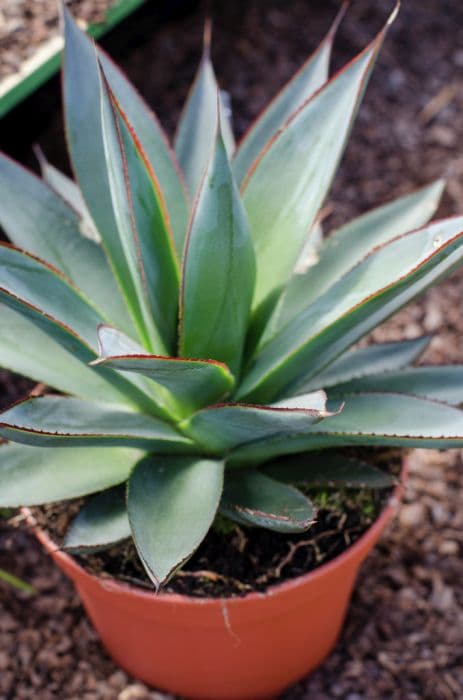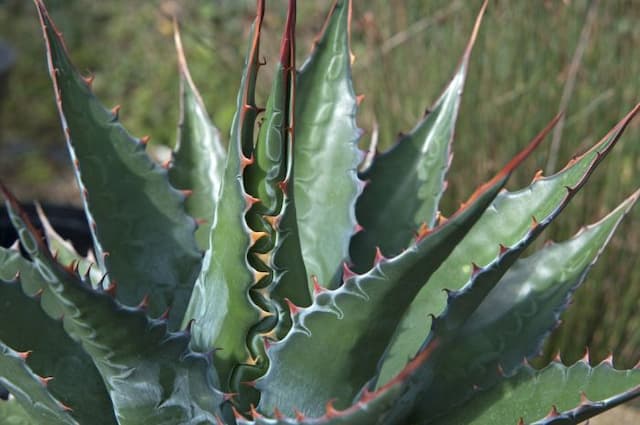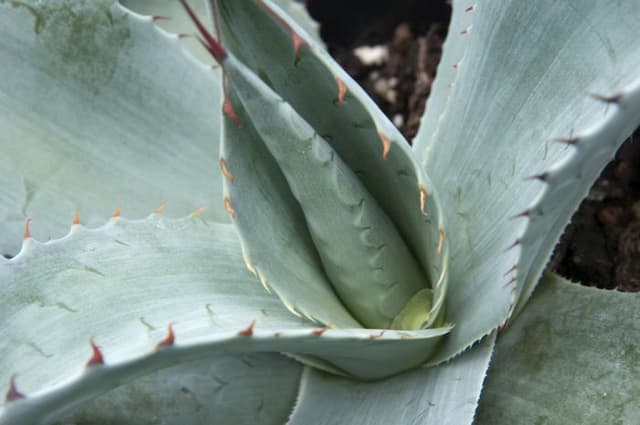Grape Hyacinth Muscari 'Joyce Spirit'

ABOUT
Muscari 'Joyce Spirit', also known as grape hyacinth, is a bulbous perennial that features distinctive dense clusters of urn-shaped flowers. The flowers appear on the upper part of the upright stem and are typically a deep cobalt blue, occasionally with a lighter, almost white rim around the edges of the petals. These attractive blooms closely resemble bunches of grapes, which is the reason behind its common name. The blossom clusters are often topped with a tuft of greenish-blue bracts, giving the plant a two-toned effect and adding to its ornamental appeal. The foliage of the grape hyacinth 'Joyce Spirit' includes a few slender, fleshy, and somewhat linear leaves. These leaves are usually a bright green color and emerge from the base of the plant. The leaves may be present when the plant is in flower or may appear after the blooming period. They contribute to the overall aesthetic with their simplicity and complement the vibrant hues of the blooms above. As the leaves mature, they typically arch gracefully, providing a lush green backdrop for the striking upright clusters of flowers.
About this plant
 Names
NamesFamily
Asparagaceae.
Synonyms
Grape Hyacinth, Bluebell.
Common names
Muscari 'Joyce Spirit'.
 Toxicity
ToxicityTo humans
The plant commonly known as Grape Hyacinth typically is not considered highly toxic to humans. However, if ingested in large quantities, parts of the plant may cause discomfort or symptoms such as nausea, diarrhea, and vomiting. Seek medical attention if significant amounts are consumed or if symptoms are severe.
To pets
Grape Hyacinth is also not highly toxic to pets, but it can still cause mild gastrointestinal upset if ingested. Symptoms in pets might include vomiting, diarrhea, and drooling. If you suspect your pet has eaten a large amount of the plant, it's best to consult a veterinarian.
 Characteristics
CharacteristicsFoliage type
Deciduous
Color of leaves
Green
Flower color
Blue
Height
6-8 inches (15-20 cm)
Spread
2-4 inches (5-10 cm)
Plant type
Bulb
Hardiness zones
4
Native area
Eurasia
Benefits
 General Benefits
General Benefits- Attractive Spring Blooms: Muscari 'Joyce Spirit', commonly known as grape hyacinth, produces vibrant blue flowers that add color to spring gardens.
- Low Maintenance: Grape hyacinths require minimal care once established, making them ideal for busy gardeners.
- Drought Tolerance: Once established, they are quite drought tolerant, reducing the need for frequent watering.
- Naturalizing: Grape hyacinths can spread and naturalize in the garden, filling out spaces and creating a lush look over time.
- Pest Resistant: They are generally resistant to pests, meaning less need for chemical treatments.
- Hardiness: Grape hyacinths are hardy in a wide range of climates and can withstand cold temperatures.
- Bee Friendly: The flowers attract bees and other pollinators, supporting the local ecosystem.
- Deer and Rodent Resistant: Grape hyacinths are not a preferred food source for deer and rodents, which helps to prevent garden damage.
- Easy to Combine: Their size and color make them easy to combine with other spring bulbs and plants for a diverse garden display.
- Container Gardening: They are suitable for growing in containers, making them versatile for patios, balconies, and other small spaces.
 Medical Properties
Medical Properties- This plant is not used for medical purposes.
 Air-purifying Qualities
Air-purifying QualitiesThis plant is not specifically known for air purifying qualities.
 Other Uses
Other Uses- Dye Production: The blue-purple flowers of grape hyacinth can be used to create a natural dye for fabrics, giving them a gentle color without the use of harsh chemicals.
- Fragrance Source: The blossoms of grape hyacinth can be used in the production of perfumes and scented oils, offering a floral note.
- Photography Subject: With its striking blue flowers, grape hyacinth provides a beautiful subject for botanical photographers and nature enthusiasts.
- Educational Tool: Grape hyacinth can be included in school projects or educational gardens to teach students about bulb growth cycles and springtime perennial plants.
- Artistic Inspiration: Artists may use the distinctive shape and color of grape hyacinth as inspiration for paintings, drawings, and textile designs.
- Floral Arrangements: Grape hyacinth can be used in floristry for adding unique structure and color to bouquets and floral decorations.
- Culinary Accent: The flowers can sometimes be crystallized and used as edible decorations on cakes and desserts, giving a touch of elegance.
- Garden Borders: Grape hyacinth can serve as a natural border in gardens, discerning different areas with its low growth habit and vibrant color.
- Signature Plantings: Grape hyacinth can be used to create signature plantings in public parks or gardens that become recognizable features of the landscape.
- Luck Symbol: In some cultures, planting grape hyacinth might be seen as bringing good luck to a garden or home through its bright and cheerful appearance in spring.
Interesting Facts
 Feng Shui
Feng ShuiThe Grape Hyacinth is not used in Feng Shui practice.
 Zodiac Sign Compitability
Zodiac Sign CompitabilityThe Grape Hyacinth is not used in astrology practice.
 Plant Symbolism
Plant Symbolism- Constancy and Stability: Muscari, commonly known as Grape Hyacinth, often symbolizes steadfastness and reliability due to its ability to return each spring with little to no maintenance.
- Trust: The durable nature of the Grape Hyacinth can also represent trust and the concept of enduring friendships or relationships.
- New Beginnings: As a spring bloomer, the Grape Hyacinth is emblematic of new beginnings and rebirth, as it's one of the first plants to emerge after winter.
- Peace and Tranquility: The soft blue hues of the Muscari 'Joyce Spirit' are often associated with calmness and serenity.
- Power: Despite its delicate appearance, Grape Hyacinth signifies power, due to its resilience and ability to thrive in various conditions.
 Water
WaterGrape hyacinths need to be watered moderately when active growth is evident, generally in the spring and fall. During these growth periods, watering about once a week with approximately 1 inch of water should be sufficient. The soil should be kept moist but not waterlogged. Reduce watering after the foliage begins to die back following the blooming period as the bulbs enter dormancy. During dormancy, especially in summer, water sparingly, providing just enough moisture to prevent the soil from completely drying out.
 Light
LightGrape hyacinths prefer full sun to partial shade. Plant them in a location where they receive at least 4-6 hours of sunlight daily. Too much shade can reduce flowering and cause the plants to become leggy, while the right amount of sunlight encourages vigorous growth and abundant blooms.
 Temperature
TemperatureGrape hyacinths are hardy and can tolerate a range of temperatures. They can survive minimum temperatures as low as 20°F and are comfortable up to around 80°F. For optimal growth, they prefer temperatures between 50°F and 65°F. These cooler temperatures are especially important during their blooming period in spring.
 Pruning
PruningGrape hyacinths do not require extensive pruning. After flowering, allow the foliage to die back naturally, which nourishes the bulbs for the next season. Remove spent blooms if desired to maintain a tidy appearance. Pruning is best done after the leaves yellow, usually several weeks post-flowering, indicating that the plant is entering dormancy.
 Cleaning
CleaningAs needed
 Soil
SoilGrape hyacinths, including 'Joyce Spirit', thrive in well-draining soil with a slightly acidic to neutral pH of around 6.0 to 7.0. A good soil mix for these plants would be equal parts loamy garden soil, peat, and sharp sand, which ensures proper drainage and aeration while retaining enough moisture.
 Repotting
RepottingGrape hyacinths like 'Joyce Spirit' typically do not need frequent repotting and can be repotted every 3-4 years or when they become noticeably pot-bound.
 Humidity & Misting
Humidity & MistingGrape hyacinths, including 'Joyce Spirit', prefer moderate humidity levels but are tolerant of a range of conditions as long as they are not in excessively dry air.
 Suitable locations
Suitable locationsIndoor
Place in a sunny spot, ensure good drainage, and avoid overwatering.
Outdoor
Plant in full sun to partial shade, in well-drained soil.
Hardiness zone
4-8 USDA
 Life cycle
Life cycleThe life cycle of Muscari 'Joyce Spirit', commonly known as Grape Hyacinth, begins with seed germination, which is typically in the spring when the soil warms. After germination, the plant develops a rosette of narrow, strap-like leaves through which it carries out photosynthesis and stores energy. This is followed by a period of vegetative growth, during which the plant establishes a strong root system and bulb for nutrient storage. In subsequent seasons, usually in early to mid-spring, the Grape Hyacinth enters the flowering stage, producing dense clusters of small, bell-shaped, blue to purple flowers on stiff, upright stems. After flowering, the plant sets seed, which may be dispersed by wind or animal activity, while the foliage dies back and the plant enters a dormant phase during the summer. During dormancy, the bulb survives underground, and with the arrival of cooler temperatures in autumn, the plant begins to prepare for the next growing season.
 Propogation
PropogationPropogation time
Spring-early summer
The Muscari 'Joyce Spirit', commonly known as Grape Hyacinth, is frequently propagated by division, an approach that is best undertaken in the fall after the plant has finished flowering and the foliage has died back. You would gently lift the clump of bulbs from the ground using a garden fork, being careful not to damage the bulbs. Once lifted, you can separate the smaller offset bulbs from the main bulb, which are essentially clones of the parent plant. These offsets can be replanted immediately at a depth of about 3 to 4 inches (7.5 to 10 centimeters) and spaced about 3 inches (7.5 centimeters) apart in well-draining soil with exposure to full sun to partial shade. Water the newly planted offsets well to establish them. This method of propagation allows for quick increase of your Grape Hyacinth collection and also rejuvenates older clumps that might be flowering less prolifically.









